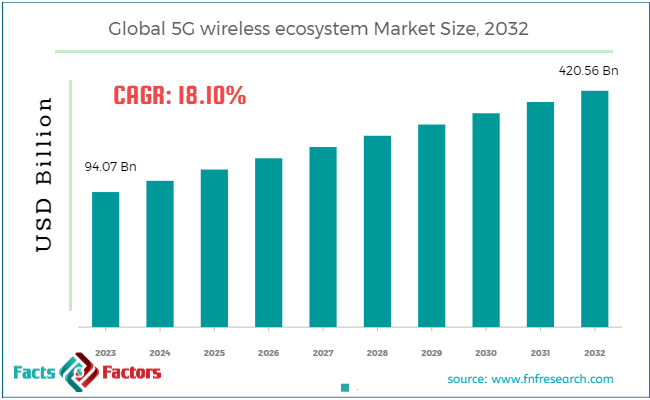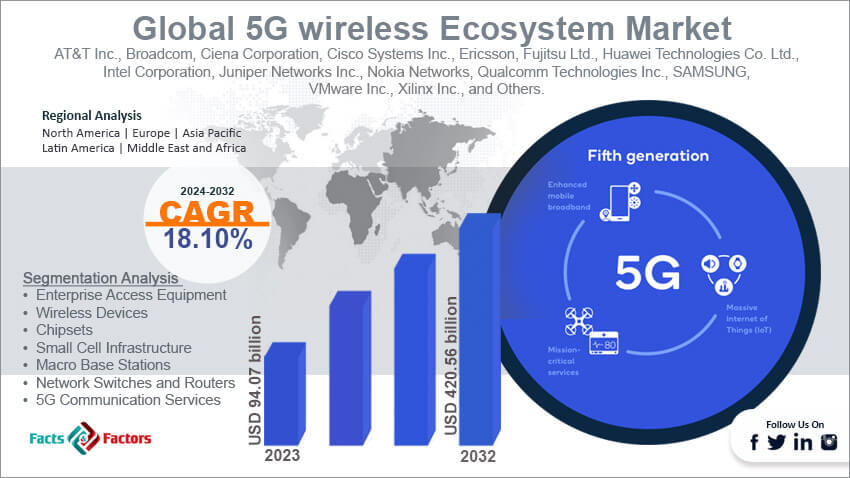Search Market Research Report
5G wireless Ecosystem Market Size, Share Global Analysis Report, 2024 – 2032

5G wireless Ecosystem Market Size, Share, Growth Analysis Report By Component (Enterprise Access Equipment, Wireless Devices, Chipsets, Small Cell Infrastructure, Macro Base Stations, Network Switches and Routers, 5G Communication Services), By End User (Consumers, Enterprises (manufacturing, healthcare, etc.), Public Safety, Others), And By Region - Global and Regional Industry Insights, Overview, Comprehensive Analysis, Trends, Statistical Research, Market Intelligence, Historical Data and Forecast 2024 – 2032
Industry Insights
[210+ Pages Report] According to Facts & Factors, the global 5G wireless ecosystem market size in terms of revenue was valued at around USD 94.07 billion in 2023 and is expected to reach a value of USD 420.56 billion by 2032, growing at a CAGR of roughly 18.10% from 2024 to 2032. The global 5G wireless ecosystem market is projected to grow at a significant growth rate due to several driving factors.

 Global 5G Wireless Ecosystem Market: Overview
Global 5G Wireless Ecosystem Market: Overview
The 5G wireless ecosystem comprises an intricate network of interconnected firms and technologies that collectively enable the functioning of 5G. 5G encompasses more than simply ultra-fast internet speeds. Network operators, such as Verizon or Jio, are the entities that offer 5G services to clients. They construct and uphold the infrastructure responsible for transmitting the signal.
Device makers are the entities responsible for conceptualizing and constructing mobile phones and other electronic devices capable of connecting to a 5G network, such as Samsung or Apple. Chipmakers, such as Qualcomm, are responsible for producing the semiconductors that enable the functionality of 5G technology.
Software development companies specialize in designing applications and services specifically for 5G networks. They are crucial for facilitating the novel experiences made possible by 5G. Spectrum providers are the entities responsible for overseeing and assigning the radio frequencies utilized by 5G. The spectrum is an essential asset that enables the functionality of 5G.
Integrating many components enables 5G to provide benefits such as high-speed data transmission, minimal delay, and extensive network capacity. These advancements create opportunities for emerging technologies such as autonomous vehicles, telemedicine procedures conducted from a distance, and the interconnected network of everyday objects known as the Internet of Things (IoT).
 Key Highlights
Key Highlights
- The 5G wireless ecosystem market has registered a CAGR of 18.10% during the forecast period.
- In terms of revenue, the global 5G wireless ecosystem market was estimated at roughly USD 94.07 billion in 2023 and is predicted to attain a value of USD 420.56 billion by 2032.
- The growth of the 5G wireless ecosystem market is being propelled by the increasing demand for high-speed internet connections, the growth of the internet of things (IoT), and endorsement and financial investment from the government.
- On the basis of Component, the chipset segment is dominant because of the growing need for powerful processors that can handle high data speeds and low latency, which are connected with 5G technology.
- Based on End User, the consumer segment is projected to see a high compound annual growth rate (CAGR) as a result of increasing demand for faster mobile data experiences.
- On the basis of region, the North America and APAC regions currently hold dominant positions.

 5G Wireless Ecosystem Market: Dynamics
5G Wireless Ecosystem Market: Dynamics
The 5G wireless ecosystem is a complex network of companies involved in developing, deploying, and using 5G technology. This market is experiencing significant growth, driven by several factors, but also faces challenges and limitations. Here's a quick overview of the key dynamics:
 Growth Drivers:
Growth Drivers:
- Technological Advancements: Continuous innovation in areas like beamforming, network slicing, and advanced antennas enhance network performance and unlock new applications.
- Surging Demand: Consumers are increasingly demanding faster speeds, seamless connectivity, and richer mobile experiences, fueling the need for 5G.
- Emerging Applications: 5G opens doors for revolutionary applications like the Internet of Things (IoT), autonomous vehicles, and immersive technologies like AR/VR.
 Restraints:
Restraints:
- High Infrastructure Costs: Deploying and maintaining 5G networks requires significant investments in infrastructure like base stations and fiber optic cables.
- Spectrum Availability: Access to suitable radio frequency spectrum is crucial for 5G deployment. Government regulations and competition can limit spectrum availability.
- Device Compatibility: Not all devices are currently 5G-enabled, creating a temporary barrier to widespread adoption.
 Opportunities:
Opportunities:
- Enterprise Adoption: Businesses across various sectors can leverage 5G for enhanced efficiency, automation, and innovation.
- Vertical Integration: Collaboration between ecosystem players can accelerate development and deployment of customized 5G solutions for specific industries.
- Emerging Markets: Developing regions with limited existing infrastructure represent a vast potential market for 5G adoption.
 Challenges:
Challenges:
- Security Concerns: Ensuring data privacy and network security in a high-speed, high-capacity environment like 5G requires robust security protocols.
- Standardization: Maintaining interoperability between different equipment vendors and service providers is crucial for seamless global adoption.
- Evolving Regulations: Governments need to adapt regulations to keep pace with technological advancements and address emerging challenges related to data usage and privacy.
By understanding these dynamics, stakeholders in the 5G ecosystem can make informed decisions to navigate the market landscape and capitalize on the vast potential of this transformative technology.
 5G Wireless Ecosystem Market: Segmentation Analysis
5G Wireless Ecosystem Market: Segmentation Analysis
The global 5G wireless ecosystem market is divided by component, end user, and region.
 Segmentation Analysis by Component:
Segmentation Analysis by Component:
Based on Component, the global 5G wireless ecosystem market is bifurcated into enterprise access equipment, wireless devices, chipsets, small cell infrastructure, macro base stations, network switches and routers, and 5G communication services. Chipsets is the dominating segment. This segment is expected to have the highest Compound Annual Growth Rate (CAGR) due to the increasing demand for advanced processors capable of handling high data speeds and low latency associated with 5G.
Chipsets are the brains of 5G devices, responsible for processing signals and data transmission. Advancements in chipset technology are crucial for enabling features like network slicing and enhanced mobile broadband (eMBB). Enterprise Access Equipment provides connectivity for businesses within a private network. Wireless Devices sub-segmented by 5G-enabled smartphones, tablets, and other consumer devices.
 Segmentation Analysis by End User:
Segmentation Analysis by End User:
Based on End Users, the global 5G wireless ecosystem market is categorized into consumers, enterprises (manufacturing, healthcare, etc.), public safety, and others. The initial growth surge in the 5G market is driven by consumer adoption of 5G-enabled smartphones and tablets. This segment is expected to see high CAGR due to rising demand for faster mobile data experiences. Consumers are the end users who utilize 5G services for activities like streaming high-definition video, online gaming, and downloading large files.
 Report Scope
Report Scope
Report Attribute |
Details |
Market Size in 2023 |
USD 94.07 Billion |
Projected Market Size in 2032 |
USD 420.56 Billion |
CAGR Growth Rate |
18.10% CAGR |
Base Year |
2023 |
Forecast Years |
2024-2032 |
Key Market Players |
AT&T Inc., Broadcom, Ciena Corporation, Cisco Systems Inc., Ericsson, Fujitsu Ltd., Huawei Technologies Co. Ltd., Intel Corporation, Juniper Networks Inc., Nokia Networks, Qualcomm Technologies Inc., SAMSUNG, VMware Inc., Xilinx Inc., and Others. |
Key Segment |
By Component, By End User, and By Region |
Major Regions Covered |
North America, Europe, Asia Pacific, Latin America, and the Middle East &, Africa |
Purchase Options |
Request customized purchase options to meet your research needs. Explore purchase options |
 5G Wireless Ecosystem Market: Regional Analysis
5G Wireless Ecosystem Market: Regional Analysis
North America and APAC are the current dominating regions in the 5G wireless ecosystem market, fueled by high investments, government support, and a tech-savvy population. Both regions boast impressive CAGR, indicating significant growth potential.
- Asia Pacific (APAC): This region is expected to lead the market growth due to the presence of fast-growing economies like China, India, South Korea, and Japan. Government initiatives for smart city development and a large consumer base seeking high-speed internet fuel the APAC market's dominance. China, in particular, is anticipated to be a major market leader with a high CAGR (Compound Annual Growth Rate).
- North America: The U.S. is projected to be a frontrunner in the 5G market due to established network operators and government support for infrastructure development. The high disposable income and early adoption of technology further contribute to North America's strong market position.
- Europe has a stable market for 5G with consistent growth. Government investments and established technological expertise are driving the market forward.
- Latin America and Middle East & Africa regions are in the early stages of 5G adoption. However, increasing investments in infrastructure and growing demand for mobile data are expected to propel market growth in the coming years.
 5G Wireless Ecosystem Market: Competitive Landscape
5G Wireless Ecosystem Market: Competitive Landscape
Some of the main competitors dominating the global 5G wireless ecosystem market include;
- AT&T Inc.
- Broadcom
- Ciena Corporation
- Cisco Systems Inc.
- Ericsson
- Fujitsu Ltd.
- Huawei Technologies Co. Ltd.
- Intel Corporation
- Juniper Networks Inc.
- Nokia Networks
- Qualcomm Technologies Inc.
- SAMSUNG
- VMware Inc.
- Xilinx Inc.
The global 5G wireless ecosystem market is segmented as follows:
 Segmentation Analysis By Component:
Segmentation Analysis By Component:
- Enterprise Access Equipment
- Wireless Devices
- Chipsets
- Small Cell Infrastructure
- Macro Base Stations
- Network Switches and Routers
- 5G Communication Services
 Segmentation Analysis By End User:
Segmentation Analysis By End User:
- Consumers
- Enterprises (manufacturing, healthcare, etc.)
- Public Safety
- Others
 By Regional Segment Analysis
By Regional Segment Analysis
- North America
- The U.S.
- Canada
- Mexico
- Europe
- France
- The UK
- Spain
- Germany
- Italy
- Rest of Europe
- Asia Pacific
- China
- Japan
- India
- Australia
- Southeast Asia
- Rest of Asia Pacific
- The Middle East & Africa
- Saudi Arabia
- UAE
- Egypt
- Kuwait
- South Africa
- Rest of the Middle East & Africa
- Latin America
- Brazil
- Argentina
- Rest of Latin America
Industry Major Market Players
- AT&T Inc.
- Broadcom
- Ciena Corporation
- Cisco Systems Inc.
- Ericsson
- Fujitsu Ltd.
- Huawei Technologies Co. Ltd.
- Intel Corporation
- Juniper Networks Inc.
- Nokia Networks
- Qualcomm Technologies Inc.
- SAMSUNG
- VMware Inc.
- Xilinx Inc.
Frequently Asked Questions

Copyright © 2024 - 2025, All Rights Reserved, Facts and Factors


